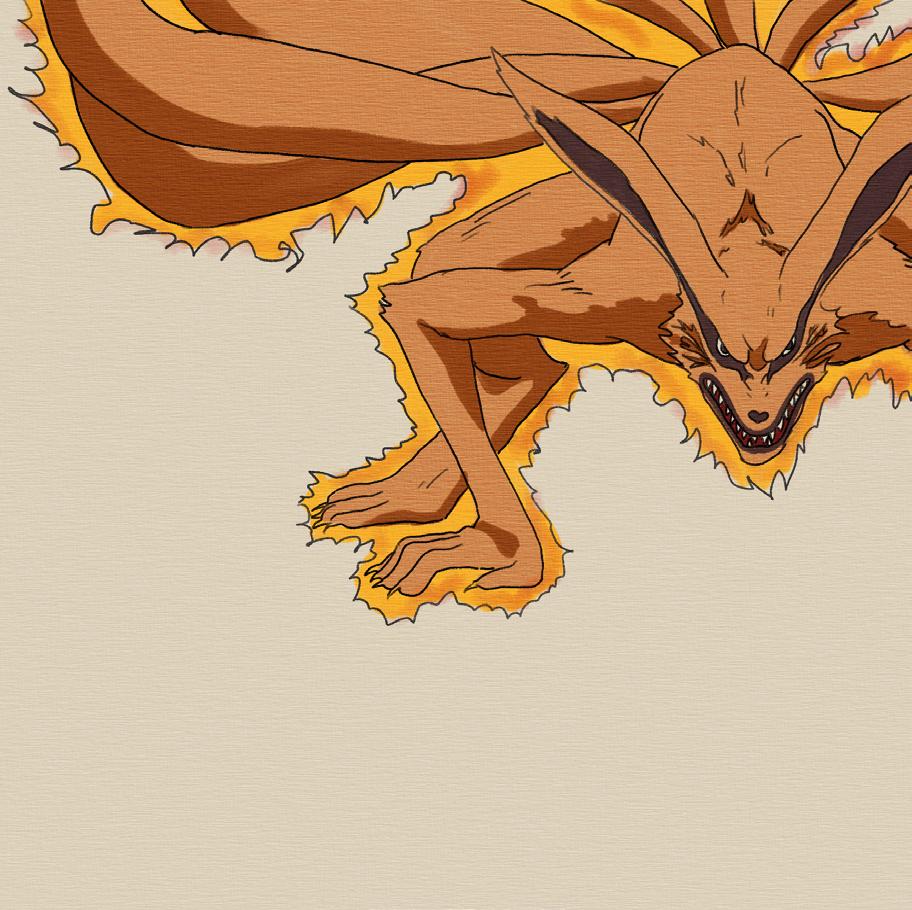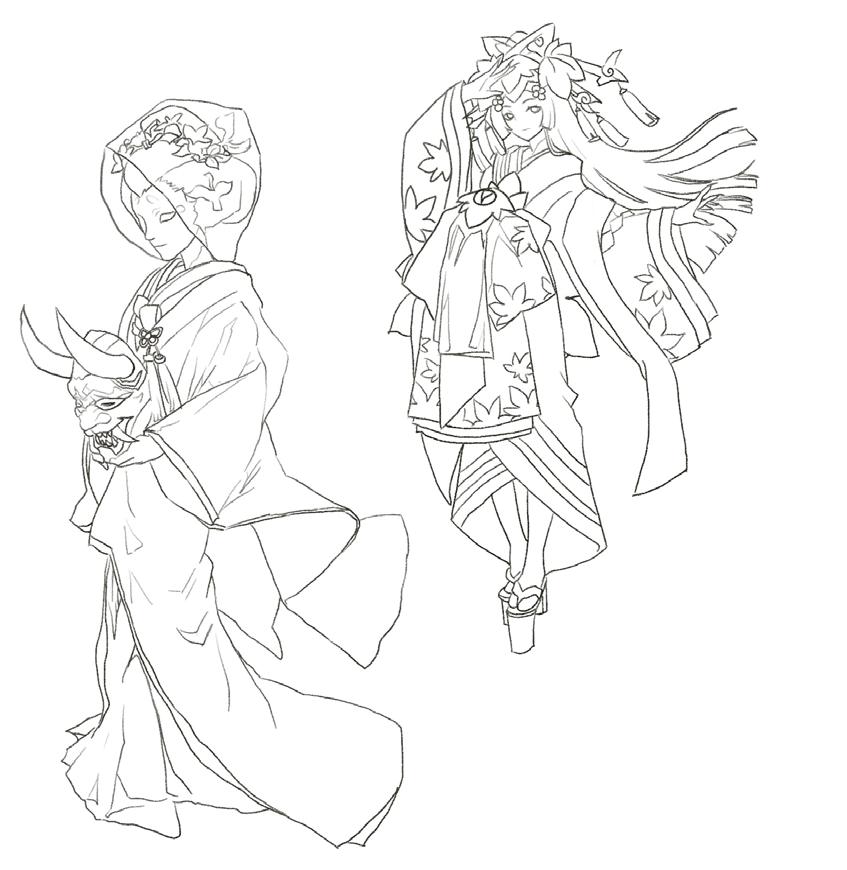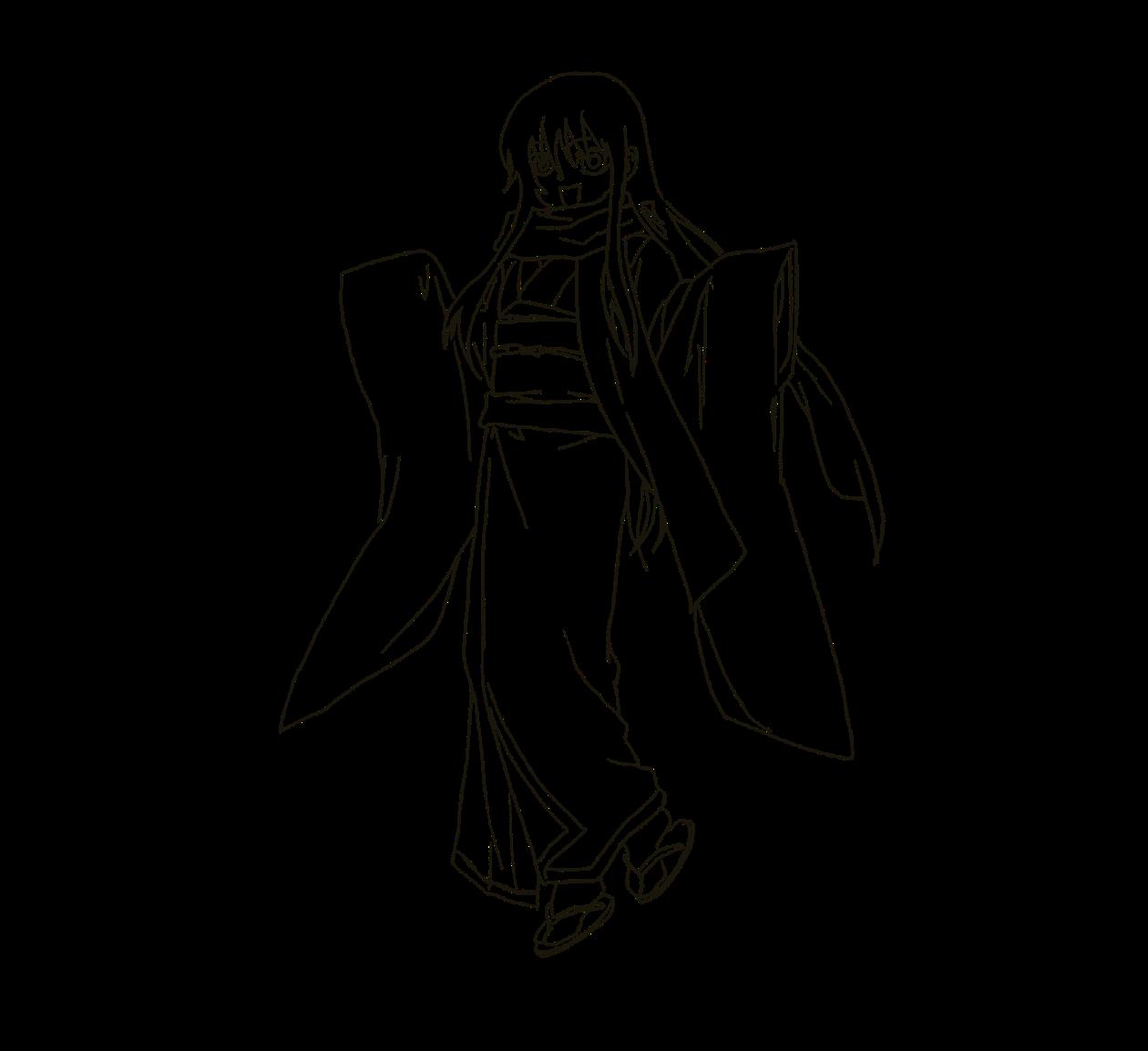
Illustration Book: Past and Present of Five Supernatural Spirits Illustrated by Qiyang (Octavia) Zhou 周起扬

歌舞伎からアニメまで
五つの超自然の存在の過去と現在
Catalogue of 5 Supernatural Spirits: Exploring the Past and Present Illustrated by Qiyang (Octavia) Zhou 周起扬
Contents
猫又 Nekomata Cat yokai in Japanese folklore
狐 Kitsune
Fox yokai that can shape-shift to human form
雪女 Yuki-onna
The snow woman
雷神 Raijin
The god of lightning, thunder, and storms
紅葉 Momiji Oni from Momijigari 紅葉狩

序文Foreword
The purpose of the final creative project, "From Kabuki to Anime: Past and Present of Five Supernatural Spirits" is to showcase the transcendent and transcultural evolution of various spirits, demons, and kami found in traditional Japanese tales and performances. Each supernatural entity selected for this handdrawn catalogue exemplifies the essence of metamorphosis: for example, kitsune, the fox trickster who would turn into human form to make fun of or seduce men; narukami, the thunder god in the famous kabuki play who is originally an evil priest; yukionna, the snow woman who disappeared into a puff of snow. This horizontal transformation is further complemented by a vertical mutation. These characters, as they were known in premodern folklores and theatre, have been reimagined and recreated by modern popular culture. Once fearsome kami and demons, they have now taken the form of adorable anime girls or have found their place in a vast array of video games. The term bakemono 化け物 , which serves as an alternative name for yōkai, literally translates to "a thing that changes," meaning that they constantly evolve, mutate, and could change with the function of time. From exploring characters in traditional kabuki and noh theatre to experiencing them in present-day anime and video games, the physical transformation of yōkai signifies that oral traditions, performance arts, and media are in a constant state of evolution, continuously evolving in a collection of embodied memories.
The final project is a culmination of the course's exploration of the ways in which East Asian performance becomes sites of disciplinary intervention and innovation. It takes inspiration from various guest lectures across the quarter: Rika (Yoshinojō) Lin’s Nihon buyō workshop, where we learned about the artist’s collaborative project “Suji 筋 ): Lines of Tradition” with puppet artist Tom Lee, which served as a captivating example of reimagining heritage, transcending conventional performance norms, and exploring profound questions surrounding the self and identity; and, the performance by Irene Hsiao “Untitled (after Tang Chang),” where the demonstration of visceral engagement with painting served as an ongoing source of inspiration for Irene's dance choreography. Additionally, the project is influenced by a previous visit to the Smart Museum, where I examined a
series of kabuki woodblock prints showcasing renowned kabuki actors. Notably, the kabuki sugoroku (illustrated board game) exemplifies the interconnectedness between gameplay and the appreciation of ukiyo-e artworks. The expansive woodblock depicts pairs of heroes from the kabuki stage, with each square panel representing a specific kabuki play, serving as a collectible reference manual for ardent kabuki fans. In a similar vein, this project incorporates elements from the sugoroku board games. Through gameplay, participants not only experience the excitement of the game but also acquire knowledge about the rich world of kabuki acting, effectively transforming the game into an educational reference tool. According to Kawaga Masanobu, in the late 18th century, the proliferation of reference materials on supernatural entities led to their detachment from orally transmitted narratives. Instead, they became known to the public solely through names and visual characteristics – “[like] animals at the zoo, yōkai came to exist as just another creature… they existed only as fictionalized characters.” Expanding on these concepts, the final illustrated book sought to delve into the idea of contextual detachment through the media of a reference manual. In present-day popular culture, traditional characters depicted in games, anime, and films often appear completely divorced from their original folk stories. Their rebirth in the modern world is accompanied by unfamiliar anecdotes, altered sexuality, and even the loss of their original names over time. They are stripped of their mystic and are relegated to the realm of public reimagination. They gradually disappear. Their origins become invisible. What remains is a vague concept, transformed and reshaped to align with the taste of a contemporary audience.
The final project encompasses a collection of five spirits and their various manifestations, totaling twenty unique depictions derived from traditional performances, anime, and video games. The catalogue's layout has been meticulously crafted using Adobe InDesign, ensuring that it can be easily printed into a physical booklet with dimensions of 170mm x 257mm. Taking inspiration from a diverse array of visual resources, my artwork draws upon the elegant ukiyo-e prints of Keisai Eisen 溪斎英 泉 , renowned for his distinctive slender-style bijin-ga beauty
paintings. Additionally, I explored various recordings of kabuki and noh performances, immersing myself in the rich visual imagery of these traditional art forms. To provide transparency, I have included a comprehensive list of the visual reference materials used in the inner pages of the catalogue. Moreover, each character's mutation is accompanied by a text box, offering a concise explanation of its origins and stories, allowing viewers to appreciate the influences that have shaped the artwork and providing a deeper understanding of its contextual background. In refining my concepts for the character’s drawings, I found support from my tablet and the iArtbook app. These tools facilitated the creative process, enabling me to experiment, revise, and perfect the visual representations with greater precision and fluidity. Through this blend of traditional and modern techniques, the final catalogue merges the world of ukiyo-e, kabuki, and noh with contemporary digital artistry.
Initially, the intention was to conduct a comprehensive exploration of diverse supernatural entities in the traditional theater and exploring the various categories of oni, onryō, kami, and demons. However, due to time constraints and limitations in my painting techniques, the final illustrations book is reduced to five selections from the original eleven characters. In the process, it became evident that it was impossible to encompass every film, manga, or game that draws inspiration from a specific character. Therefore, the choices were limited to those works I am personally familiar with within the realm of East Asian popular culture, resulting in a curated selection. Despite these constraints, the final project remains an attempt to explore the tapestry of supernatural spirits and evolving roles in East Asian folklore and popular culture. The chosen characters and their diverse representations serve as glimpses into the expansive world of yōkai, kami, and ghosts, hoping to capture their essence and significance. While the scope may be narrower than initially envisioned, the illustrations and accompanying descriptions, accompanied with an additional website with listed inspirations, provide a captivating exploration of these entities, inviting readers to delve into the vibrant realm of East Asian myth and storytelling.
猫又 Nekomata
*To August Ye*
Matatabi 又旅 (aka Two Tail 二尾)
From Naruto
Matatabi is one of the tailed beasts in Naruto. He has two tails, like the bakeneko, and is surrounded by blue flames. It also has heterochromatic eyes. Its attacks mainly uses fire and flames.
Kirara 綺良良
From Genshin Impact


She is a courier from Komaniya Express, and also a hardworking nekomata who controls grass. She loves human society.


Visual Reference: Face of the cat inspired by Utagawa Kuniyoshi. Cats Enjoying the Evening Cool (猫のすずみ), 1839-1842. Woodblock print. http://www. kuniyoshiproject.com/Fan%20 prints%20of%20humorous%20 and%20miscellaneous%20 subjects,%20part%20I.htm
Kimino of the cat inspired by Yoshitoshi Taiso, "Shingata Sanjuroku Kai Sen" (New Forms of Thirtysix Ghosts) The spirit of Komachi cherry tree in the kabuki play, "Tsumoru Koi Yuki Seki no To". Meiji 1868-1912. Woodblock print.
狐 Kitsune

Visual Reference:
Kitsune mask appearance referencing noh mask website photographs: https:// nohmask21.com/eu/kitsune1.html
Geisha appearance and kimono referencing and inspired by ukiyo-e prints of beauty by Japanese artist Keisai Eisen. Ikeda, Eisen, and Ukiyoe Ota Kinen Bijutsukan. Keisai Eisen
Ten: Bakumatsu Bijinga No Kyoshō. Tōkyō: Ukiyoe Ota Kinen Bijutsukan, 1983. 溪斎英泉展 : 幕末美人画の巨 匠.
Genkuro's appearance inspired from woodblock print Kabuki Actor Nakamura Shikan as Genkuro by artist Shunbaisai Hokuei 春梅斎北英 (active 1824-1837). https://asia.si.edu/ explore-art-culture/collections/search/ edanmdm:fsg_S2004.3.287/
Genkuro 源九郎
A shape-shifting kitsune character in kabuki play Yoshitsune and the Thousand Cherry Trees (Yoshitsune Senbon Zakura)


Yae Miko 八重神子
A kitsune in Genshin Impact RPG game. She is the priestess at the Narukami shrine serving Raiden Shogun, the goddess of thunder.

Kurama 九喇嘛
The nine-tailed beast being sealed in the body of Naruto Uzumaki. It is the most powerful of the tailed beast in Naruto, and became a tool and weapon used for ninja wars.

Kitsune is a well-known shape-shifting yokai (supernatural creature) in folklore. These clever creatures are notorious for their deceptive and cunning behavior, often using their shapeshifting abilities to deceive people. According to Lafcadio Hearn, a writer who collected strange tales in Japan, some foxes are considered benevolent and associated with Inari-Okami, the deity of agriculture, rice, sake, and fertility.
Legend has it that Inari descended from Heaven riding on a white fox, carrying sheaves of grain, during a severe famine in Japan. Hence, white foxes are regarded as messengers of Inari Okami.
Kitsunes have a hierarchical structure, with a fox taking 500 years to change its color from red to white. At this stage, it gains the ability to transform into anything and possesses various supernatural powers.
Fox spirits are known as tricksters who enjoy playing pranks on humans. One of the kitsune's favorite transformations is into a woman, often done to mock, frighten, or even seduce men. Fox-mothers, fox weddings, fox women, and fox possession stories abound in Japanese folklore.
In one particular tale depicted in Yoshitoshi's print "The Fox-woman Leaving Her Child," a fox, rescued by a nobleman from hunters, transforms into a beautiful young woman to express gratitude and marries him. They live together for many years, and the fox-woman bears him a child. In this print, the identity of the kitsune is revealed through the shadows cast on the sliding screen. The prevalence of fox stories involving transformations between fox and woman suggests a direct link between the perception of foxes and that of women.

雪女 Yuki-Onna

The Heron Maiden
The old legends surrounding yuki-onna, the snow woman, are predominantly tales of sorrow. These narratives originated from the experiences of individuals who lived somber lives, including childless elderly couples and solitary men dwelling in mountainous villages. They would hear the haunting sound of a blizzard tapping on their shuttered
From Kabuki play Sagi Musume. Though the heron maiden is not directly linked to Yuki Onna, the setting of freezing winter, the dance of torments and pity in the final performance amidst the falling snow demonstrated the idea of mono-no-aware - the transcience of things. Snow, as a substance that quickly melts in warmer air, is an embodiment of impermanence. This sadness in the passing of things is also expressed in Sagi Musume. doors and indulge in fantasies that their deepest desires had finally arrived. These ephemeral visions of happiness, as transient as snow, allowed them to momentarily dwell in a world where their longings were fulfilled. Lafcadio Hearn's story of Yuki Onna, depicted her as a spirit that returned as a woman with everlasting beauty in order to pursue humanly love.

雪Yuki/Snow, from Kongo-school Noh. In the Noh Yuki, a priest on his way to the Tennōji temple is caught in a snowstorm when he encounters a mysterious woman, who in reality is the spirit of snow. After reading a sutra, the woman dances as she disappears in a whirlwind of snow.

Tsurara Oikawa 及川 氷麗
A Yuki-onna spirit from Nura: Rise of the Yokai Clanぬらりひょんの孫. Around the Nura House, she sometimes acts as a cook who makes delicious but usually chilled or cold food. Her eyes are dark blue while in human form and golden while in yokai form.

Visual Reference:
Noh illustration inspired by the ukiyoe prints of Tsukuoka Kogyo月岡 耕漁, the Nōgaku hyakuban (Prints of One Hundred Noh Plays) series.
Noh appearance adopted from a recorded video of Yuki (Kongo School) on youtube https://youtu.be/Nl4bkbzMUz0
Heron Maiden illustration inspired by Bando Tamasaburo's performance (2009) in the dance's final sequence - in the ebizori pose.
Yuki-Onna, from In/Spectre 虚構推理



雷神 Raijin

Narukami 鳴神 from kabuki play Narukami
Narukami is a originally a priest who turned into a thunder god after being deceived by a princess. When he transformed into the thunder god, we see him in the Mie pose in a costume with orange-red flames. d
Raijin is a demon-like god in Japanese mythology, portrayed as a thunder-wielding deity who plays drums. His intimidating depiction often invokes fear, particularly among children. In ancient Japanese folklore, there is a well-known tale associating Raijin with the act of
consuming the navels of young children. Consequently, when storms or thunder occur, parents commonly caution their children to conceal their bellybuttons as a means of safeguarding themselves against the arrival of Raijin.


Visual Reference:
Raijin Kabuki figure inspired by woodblock print by Kunisada III: https://www.fujiarts. com/cgi-bin/item.pl?item=665895
Raijin god on the far left referencing Tawaraya Sōtatsu (1570-1643)'s folding screens "The Folding Screen of Fujin and Raijin(God of Wind and Thunder)."
Narukami kabuki figure referencing the play recorded in February 2008, at the Hakataza theatre in Fukuoka, by actors Kataoka Ainosuke VI and Nakamura Shichinosuke II. https://youtu.be/N-pqdrUZTAo
Raiden Shogun's character demo video: https://youtu.be/mvrW4aKwAXw
紅葉 Momiji

Princess Sarashina更科姫
Noh play Momojigari 紅葉狩(right)
Kabuki play Momojigari (left)
The princess is actually a mountain demon in the Togakushi mountain. After she joined maple-viewing with warrior Koremochi, she danced and hypnotized him. After Koremochi woke up he realized the true identity of the princess. The princess revealed her demon form, but was finally defeated by the warrior. The transformation in Noh theater is signified by the changing of costumes and wearing the demon mask. The legend of momijigari is also adapted into joruri puppet theatre (1715) and kabuki (1887).
Sarashinahime's captivating dance revolves around her skillful use of two fans known as 'Nimaiogi.' Unlike traditional princess dances, the movements are notably daring and vibrant. Shortly after this mesmerizing scene, Sarashina unveils her true demonic nature as she secretly observes the intoxicated and slumbering Koremochi. The color of red is meant to stress the naive and sweet elegance of the princess.


Lady Michiko (Momiji spirit) 美智子 (left)
From horror game Identity V
Lady Michiko is a killer in Identity V. She has two forms - the beauty form and the prajna form. In the beauty form, she is calm with her mask off; she attacks when she transforms into the prajna form, she would put her mask on and move with a quicker speed. She has various costumes, and the illustration here shows her wearing Japanese wedding dress Shiromuku.
Kijo Momiji 鬼女紅葉 (right)
From 3D RPG game Onmyoji
She is a spirit that dwelled in the world for love - she is rescued by a priest, Master Seimei, and she is willing to sacrifice everything for him. She devoured the living, and flesh fed her beauty. Her ultimate fatal attack is the Dance of Death.
Visual Reference:
Kabuki actor figure inspired by Momijigari performance recordings from Kabuki-in-depth channel: https:// youtu.be/k8K4DQmbQwE
Noh figure referencing the noh database photography by Toshiro Morita, accessed online: https://www.thenoh.com/en/plays/photostory/ps_014.html
List of Lady Michiko's other beautiful costumes, from Identity V, can be found here: https://id5.fandom.com/ wiki/Geisha/Cosmetics. This catalogue also includes costume Lady Thirteen 十三娘, a limited costume dressing Michiko in lavish Chinese Qipao gown.
スケッチ Sketch















参考文献
Bibliography
Addiss, Stephen, Helen Foresman Spencer Museum of Art, and Asia Society. Galleries. Japanese Ghosts & Demons: Art of the Supernatural. New York Lawrence: G. Braziller Spencer Museum of Art, University of Kansas, 1985.
Calza, Gian Carlo. Ukiyo-e. London New York: Phaidon, 2005.
Eisen Ikeda 池田英泉 and Ukiyoe Ōta Kinen Bijutsukan 浮世絵太田記念美術館 Keisai Eisen Ten: Bakumatsu Bijinga No Kyoshō 溪斎英泉展 幕末美人画の巨匠 Tōkyō: Ukiyoe Ōta Kinen Bijutsukan 東京 浮世絵太田記念美術館 1983.
Hearn, Lafcadio, Andrei Codrescu, and Jack Zipes. Japanese Tales of Lafcadio Hearn. Princeton, New Jersey: Princeton University Press, 2019.
Hiroshi Shiibashi 椎橋寛 Nura: Rise of the Yokai Clan ぬらりひょんの孫 Tokyo: Shueisha Inc. 東京都 株式会社集英社 2008.
Isumi Yamada. “Noh - ‘雪 (Yuki/Snow)’ / Kongo-School.” Translated by Yuji Kudo. 2023. https://youtu.be/Nl4bkbzMUz0.
James Rondeau --, et al. Painting the Floating World: Ukiyo-e Masterpieces from the Weston Collection. First edition. Chicago, IL: Art Institute of Chicago, 2018.
Kataoka Ainosuke VI.六代目 片岡愛之助, and Naramura Shichinosuke II. 二代目 中村七之助 “Narukami 鳴神.” 2008.
https://youtu.be/N-pqdrUZTAo.
Katz-Harris, Felicia, Kaya Laterman, and Museum of International Folk Art. Yōkai: Ghosts, Demons & Monsters of Japan.
Santa Fe: Museum of New Mexico Press, 2019.
Kitsune (FOX) mask list, 1996. https://nohmask21.com/eu/kitsunelist.html.
Kōichi Yumoto 湯本豪一 Edo No Yōkai Emaki 江戶の妖怪絵卷 Shohan. Tōkyō: Kōbunsha 東京 : 光文社 2003.
Kunisada, Utagawa 歌川国貞. “Thunder God and Wind God in a Kabuki Play.” Japan, n.d.
Masashi Kishimoto 岸本斉史 “Naruto: Shippuden 疾風伝.” Manga. Tokyo: Shueisha 東京都:株式会社集英社 2007.
MiHoYo. Genshin Impact. MiHoYo. Android/iOS/PlayStation/Windows. 2020.
MiHoYo. "Character Demo "Raiden Shogun: Judgment of Euthymia"." Genshin Impact. August 30, 2021. Video, https:// youtu.be/mvrW4aKwAXw.
Mizuki Kondō 近藤瑞木. Hyakki Ryōran: Edo Kaidan, Yōkai Ehon Shūsei 百鬼繚乱 : 江戶怪談・妖怪絵本集成 Shohan.
Tōkyō: Kokusho Kankōkai 東京 国書刊行会 2002.
“Momijigari: Kabuki Plays: Invitation to Kabuki.” Momijigari | Kabuki Plays | INVITATION TO KABUKI, 2019. https://www2.ntj.jac.go.jp/unesco/kabuki/en/play/play22.html.
Nakamura Shikan VIII. 八代目 中村芝翫 and Nakamura Kankuro VI. 六代目 中村勘九郎 “Momijigari 紅葉狩.” 2008. Video, https://www.bilibili.com/video/BV1Fx411n7hf/?share_source=copy_web&vd_source=e0a495fb9618f6d 0926b1a3e72329ec1.
NetEase Games. Identity V. NetEase Games. Windows/Android/iOS/MacOS. 2018.
NetEase Games. Onmyoji. NetEase Games. iOS/Android/Windows. 2016.
Sekien Toriyama 鳥山石燕. Zoku Hyakki 今昔画図続百鬼 Edo [Tōkyō], 1779.
Shunbaisai Hokuei 春梅斎北英 “Kabuki Actor Nakamura Shikan as Genkuro,” 1835. The Smithsonian’s National Museum of Asian Art. Japan.
Tamasaburo Bando V. 五代目 坂東玉三郎, and Paul M. Griffith. “Kabuki Dance by Tamasaburo Bando, Sagi Musume 鷺娘.” January 2009.
Toshiro Morita. “Momijigari (Autumn Foliage Viewing) PhotoStory,” 2023.
Tsukioka Kōgyo 月岡耕漁 “Kōgyo: The Art of Noh.” ULS Digital Collections, 2023. https://digital.library.pitt.edu/ collection/k%C5%8Dgyo-tsukioka-art-noh.
Tsukioka Yoshitoshi 月岡芳年. “Spirit of Cherry Tree 小町桜の精.” “Shingata Sanju-roku Kai Sen 新形三十六怪撰” (New Forms of Thirty-six Ghosts). The spirit of Komachi cherry tree in the kabuki play, Tsumoru Koi Yuki Seki no To 積戀雪関扉 1889. https://dl.ndl.go.jp/pid/1306525.
Utagawa Kuniyoshi 歌川国芳. “Cats Enjoying the Evening Cool 猫のすずみ.” 1839.
Yasuko Yokoyama 横山泰子 Edo Kabuki No Kaidan to Bakemono 江戶歌舞伎の怪談と化け物 Tōkyō: Kōdansha 東京 : 講談社 2008.
“YOSHITSUNE SENBON ZAKURA.” kabuki21. Accessed May 22, 2023. https://www.kabuki21.com/ysz.php.








































